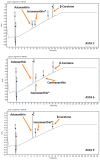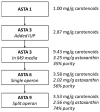Production of Astaxanthin Using CBFD1/HFBD1 from Adonis aestivalis and the Isopentenol Utilization Pathway in Escherichia coli
- PMID: 37760135
- PMCID: PMC10525928
- DOI: 10.3390/bioengineering10091033
Production of Astaxanthin Using CBFD1/HFBD1 from Adonis aestivalis and the Isopentenol Utilization Pathway in Escherichia coli
Abstract
Astaxanthin is a powerful antioxidant and is used extensively as an animal feed additive and nutraceutical product. Here, we report the use of the β-carotene hydroxylase (CBFD1) and the β-carotene ketolase (HBFD1) from Adonis aestivalis, a flowering plant, to produce astaxanthin in E. coli equipped with the P. agglomerans β-carotene pathway and an over-expressed 4-methylerythritol-phosphate (MEP) pathway or the isopentenol utilization pathway (IUP). Introduction of the over-expressed MEP pathway and the IUP resulted in a 3.2-fold higher carotenoid content in LB media at 36 h post-induction compared to the strain containing only the endogenous MEP. However, in M9 minimal media, the IUP pathway dramatically outperformed the over-expressed MEP pathway with an 11-fold increase in total carotenoids produced. The final construct split the large operon into two smaller operons, both with a T7 promoter. This resulted in slightly lower productivity (70.0 ± 8.1 µg/g·h vs. 53.5 ± 3.8 µg/g·h) compared to the original constructs but resulted in the highest proportion of astaxanthin in the extracted carotenoids (73.5 ± 0.2%).
Keywords: Adonis aestivalis; Escherichia coli; carotenoids; hydrophobic products; isopentenol utilization pathway (IUP).
Conflict of interest statement
There are no conflict of interest declared.
Figures








References
-
- Panis G., Carreon J.R. Commercial astaxanthin production derived by green alga Haematococcus pluvialis: A microalgae process model and a techno-economic assessment all through production line. Algal Res. 2016;18:175–190. doi: 10.1016/j.algal.2016.06.007. - DOI
-
- Lin Y.-J., Lin J.-Y., Wang D.-S., Chen C.-H., Chiou M.-H. Safety assessment of astaxanthin derived from engineered Escherichia coli K-12 using a 13-week repeated dose oral toxicity study and a prenatal developmental toxicity study in rats. Regul. Toxicol. Pharmacol. 2017;87:95–105. doi: 10.1016/j.yrtph.2017.05.003. - DOI - PubMed
-
- Boussiba S. Carotenogenesis in the Green Alga Haematococcus Pluvialis: Cellular Physiology and Stress Response. Physiol. Plant. 2000;108:111–117. doi: 10.1034/j.1399-3054.2000.108002111.x. - DOI
-
- Jiang G., Yang Z., Wang Y., Yao M., Chen Y., Xiao W., Yuan Y. Enhanced astaxanthin production in yeast via combined mutagenesis and evolution. Biochem. Eng. J. 2020;156:107519. doi: 10.1016/j.bej.2020.107519. - DOI
Grants and funding
LinkOut - more resources
Full Text Sources
Research Materials

